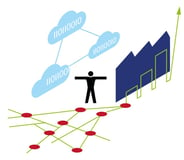How Will Industry 4.0 Impact Customer Experience?
Brian Hoey - April 12, 2018

 Industry 4.0 is already radically changing the global manufacturing landscape; so much so that Deloitte estimated that as many as half of the S&P 500 firms would be replaced by 2027 due to digital disruptions. Prognostications like this lend a sense of urgency to discussions of the adoption of Industry 4.0 principals like interoperability and cyber-physical integration. What many forget, however, is that it’s not technology alone that determines a company’s long-term staying power. Rather, it’s the customers who ultimately determine the success or failure of a given business.
Industry 4.0 is already radically changing the global manufacturing landscape; so much so that Deloitte estimated that as many as half of the S&P 500 firms would be replaced by 2027 due to digital disruptions. Prognostications like this lend a sense of urgency to discussions of the adoption of Industry 4.0 principals like interoperability and cyber-physical integration. What many forget, however, is that it’s not technology alone that determines a company’s long-term staying power. Rather, it’s the customers who ultimately determine the success or failure of a given business.
This begs the question: how will all of the technological innovations driving the so-called fourth industrial revolution improve customer experience? More specifically, how can individual emerging technologies and workflows better align your business processes with the needs of your customers, so that you can build loyalty and drive revenue? Whether you’re a large manufacturing outfit or a small shipping operation, your technology should be positioned as a tool for ensuring that the right product goes to the right customer at the right time.
Sales & Operations Execution (S&OE)
One of the most important developments that has occurred as a result of the rise of Industry 4.0 is the emergence of S&OE, a new business operation designed to bridge the gap between mid-term operational planning and day-to-day supply chain workflows. By incorporating real-time information into supply stream processes, S&OE can monitor up-to-the-minute fluctuations in demand relative to a given company’s most recent forecasts, making small adjustments in inventory usage and transport management to compensate for small, daily deviations from expectations. This process, which is only possible in interconnected Industry 4.0 systems, can add value by staving off bottlenecks and disruptions. More than that, however, it can have a stabilizing effect on processes that directly impact customer experience. For instance:
- Smarter transport routing can increase the accuracy and on-time rates of your deliveries, meaning that fewer customers will suffer from delays or, in B2C sales, disruptions of their own.
- Real-time information can boost visibility, enabling an increased degree of customer-side transparency as to stock levels, thereby empowering customers to make more informed ordering decisions.
- Increased supply chain transparency can drive smarter ordering and capacity management, leading to fewer stock shortfalls, and therefore fewer customer-facing disruptions.
Customer Data Integration
While S&OE demonstrates the value that increased supply chain visibility and transparency can have for customer experience, its benefits are largely one and the same with the more holistic operational benefits that Industry 4.0 can help bring about. For businesses that are interested in leveraging new technology specifically aimed at customer pain points, however, there are more direct steps that can be taken. At companies that boast an integrated supply chain, highly visible, accessible, and centralized customer data can be leveraged into meaningful business insights. If, for example, your business provides parts for automotive manufacturers, you can analyze data about past customer ordering habits and requirements in order to uncover potential seasonalities. In this way, it’s possible to tailor your demand forecasts to a more accurate snapshot of a given client’s needs.
Customization
By the same token, Industry 4.0 improvements can pave the way for increased customization in manufacturing. An emerging technology like 3-D printing, for instance, can help to drive rapid prototyping with dramatically shortened lead times. In this way, manufacturers can add significant value for their customers in a relatively cost effective way. With more efficient resource usage and a robust digital platform connecting physical systems to planning interfaces, companies can leverage their value chain to deliver more customized products in variant rich industries where long lead times are often the norm.
Advanced Analytics
As is the case with S&OE, advanced analytics is a crucial component of Industry 4.0 systems that stretches across the entire value chain from suppliers to customers. That said, predictive analytics can be specifically trained on integrated customer data in order to produce even more accurate demand forecasts with an even greater understanding of potential seasonalities. Rather than relying solely on past customer interactions to shape future expectations, smart forecasting technology can distill a complex set of variables and modalities into easy-to-read reports and forecasts. By the same token, prescriptive analytics can suggest process improvements that increase the overall agility of a given company’s value stream. The result is a supply chain that aligns more closely with real demand and features the flexibility needed to adjust to any unforeseen circumstances. All of this contributes to a more reliable supply stream, meaning that your customers will receive more on-time deliveries and can place future orders with increased confidence and trust—leading to a more fruitful business relationship in the long run.
LATEST POSTS
- Understand Why Production Planning Needs Specialized Solutions
- Understand Circular Economy in The Manufacturing Industry
- How Can Industry 4.0 IT Integration Be Achieved Smoothly?
- The Significance of Order Sequencing in Discrete Manufacturing
- How to improve your Supply Chain Management: The Power of Control Towers



